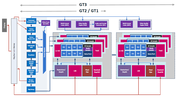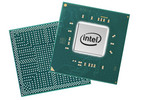Intel HD Graphics 510 vs NVIDIA Quadro K510M vs Intel UHD Graphics 600
Intel HD Graphics 510
► remove from comparison
The Intel HD Graphics 510 (GT1) is an integrated graphics unit, which can be found in low-end ULV (Ultra Low Voltage) processors of the Skylake generation. This "GT1" version of the Skylake GPU offers 12 Execution Units (EUs) clocked at up to 950 MHz (depending on the CPU model). Due to its lack of dedicated graphics memory or eDRAM cache, the HD 510 has to access the main memory (2x 64bit DDR3L-1600 / DDR4-2133).
Performance
Depending on various factors like memory configuration, the HD Graphics 510 should perform sligthly below the older HD Graphics 4400 and will handle modern games (as of 2015) only in lowest settings (if it does at all).
Features
The revised video engine now decodes H.265/HEVC completely in hardware and thereby much more efficiently than before. Displays can be connected via DP 1.2 / eDP 1.3 (max. 3840 x 2160 @ 60 Hz), whereas HDMI is limited to the older version 1.4a (max. 3840 x 2160 @ 30 Hz). However, HDMI 2.0 can be added using a DisplayPort converter. Up to three displays can be controlled simultaneously.
Power Consumption
The HD Graphics 510 can be found in mobile processors specified at 15 W TDP and is therefore suited for compact laptops and ultrabooks.
NVIDIA Quadro K510M
► remove from comparison
The NVIDIA Quadro K510M is a DirectX 11 and OpenGL 4.3 compatible graphics card for affordable mobile workstations. It is a Kepler-based GPU built on the GK107 chip with 192 out of 384 shader cores activated and is manufactured in 28nm at TSMC. The Quadro K510M is built for the Intel Shark Bay generation (Haswell) and is a successor to the Quadro K500M (Chief River platform). As a new feature, PCIe 3.0 is supported for the first time. The K510M usually comes with 1 GB GDDR5 VRAM clocked at 600 MHz (2400 MHz effective, 19.2 GB/s).
The Quadro series offers certified drivers that are optimized for stability and performance in professional applications like CAD or DCC. OpenGL performance, for example, should be significantly better than with GeForce graphics cards of similar specifications.
Architecture
The Kepler architecture is the successor to the Fermi architecture that first appeared in laptops with the GeForce 400M series. The GK107 Kepler core offers two shader blocks, called SMX, that are clocked at the same speed as the central core. In the K510M, only one block is active leading to the 192 CUDA cores. Although more shader cores are available in the Kepler architecture as compared to the Fermi design, the Kepler shaders are still expected to be up to twice as power efficient. However, due to the missing hot clock of the shader domain, two shaders of a Kepler chip offer similar performance to just one shader of a Fermi chip (as the latter is clocked twice as fast).
Performance
The performance should be clearly above the old Quadro K500M, but somewhat below the higher clocked Quadro K610M. This would place the K510M between the consumer GPUs GeForce 710M and GT 720M. However, the exact core clock has not yet been confirmed. Nevertheless, most demanding games of 2013 will run fluently only in low detail settings.
Features
The improved feature set now includes support for up to 4 active displays. Furthermore, high resolution monitors of up to 3840 x 2160 pixels can now be connected using DisplayPort 1.2 or HDMI 1.4a if available. HD-Audio codecs, such as Dolby TrueHD and DTS-HD, can be transmitted via bitstream mode through the HDMI port. However, as most laptops will feature Optimus, the integrated GPU will likely have direct control over the display ports and may limit the feature set available by the Nvidia Kepler cards. Please note: The K510M does not supprt 3D Vision Pro.
Using CUDA or OpenCL 1.2, the cores of the Quadro K510M can be used for general calculations.
The 5th generation PureVideo HD video processor (VP5) is also integrated in the GK107 core and offers hardware decoding of HD videos. Common codecs such as MPEG-1/2, MPEG-4 ASP, H.264 and VC1/WMV9 are fully supported up to 4K resolutions while VC1 and MPEG-4 are supported up to 1080p. Two streams can be decoded in parallel for features such as Picture-in-Picture. Another novelty is the inclusion of a dedicated video encoding engine similar to Intel QuickSync that can be accessed by the NVENC API.
The power consumption of the Quadro K510M is rated at a TGP of 30 W including the board and memory components. Therefore, the card is suited for medium-sized notebooks with 15-inch displays or greater.
Intel UHD Graphics 600
► remove from comparison
The Intel UHD Graphics 600 is an integrated processor graphics unit from the Gemini Lake generation (e. g. Pentium N4100), which was announced late 2017. The GPU can convince with low consumption figures, but the performance is only in the low-end segment and is rarely sufficient for modern games. Being the lowest configuration of the Gemini Lake GPU, the UHD Graphics 600 is equipped with 12 of the 18 Execution Units (EUs) running at up to 700 MHz. The technical specifications of the GPU are based on Intel's Gen9 architecture, which is also used for the more expensive Skylake series and also in the predecessor HD Graphics 505.
Due to its lack of dedicated graphics memory or eDRAM cache, the UHD 605 has to access the main memory via processor (2x 64bit DDR4/LPDDR4-2400).
Performance
The UHD Graphics 600 offers a similar performance as the Intel HD Graphics 500 in the Apollo Lake SoCs (same Gen 9 architecture). Therefore, the GPU is only suited for some very low demanding games like Dirt Rally or Sims 4.
Features
The video engine decodes H.265/HEVC (8b and 10b) and VP9 completely in hardware. Up to three displays can be connected via DP 1.2a/eDP 1.3 or HDMI 2.0a (including HDCP 2.2).
Power Consumption
The TDP of the whole Pentium N4100 chip is 6 Watts by default, so the GPU is primarily used for (often passively cooled) netbooks or thin notebooks. The TDP can also be reduced to 4.8 Watts, but this will obviously affect the performance.
| Intel HD Graphics 510 | NVIDIA Quadro K510M | Intel UHD Graphics 600 | |||||||||||||||||||||||||||||||||||||||||||||||||||||||||||||||||||||||||||||||||||||||||||||||||||||||||||||||||||||||||||||||
| Gen. 9 Series |
|
|
| ||||||||||||||||||||||||||||||||||||||||||||||||||||||||||||||||||||||||||||||||||||||||||||||||||||||||||||||||||||||||||||||
| Codename | Skylake GT1 | Gemini Lake | |||||||||||||||||||||||||||||||||||||||||||||||||||||||||||||||||||||||||||||||||||||||||||||||||||||||||||||||||||||||||||||||
| Architecture | Gen. 9 Skylake | Kepler | Gen. 9 Gemini Lake | ||||||||||||||||||||||||||||||||||||||||||||||||||||||||||||||||||||||||||||||||||||||||||||||||||||||||||||||||||||||||||||||
| Pipelines | 12 - unified | 192 - unified | 12 - unified | ||||||||||||||||||||||||||||||||||||||||||||||||||||||||||||||||||||||||||||||||||||||||||||||||||||||||||||||||||||||||||||||
| Core Speed | 300 - 950 (Boost) MHz | 846 MHz | 300 - 700 (Boost) MHz | ||||||||||||||||||||||||||||||||||||||||||||||||||||||||||||||||||||||||||||||||||||||||||||||||||||||||||||||||||||||||||||||
| Memory Bus Width | 64/128 Bit | 64 Bit | 64/128 Bit | ||||||||||||||||||||||||||||||||||||||||||||||||||||||||||||||||||||||||||||||||||||||||||||||||||||||||||||||||||||||||||||||
| Memory Type | DDR3/DDR4 | GDDR5 | DDR4 / LPDDR4 | ||||||||||||||||||||||||||||||||||||||||||||||||||||||||||||||||||||||||||||||||||||||||||||||||||||||||||||||||||||||||||||||
| Shared Memory | yes | no | yes | ||||||||||||||||||||||||||||||||||||||||||||||||||||||||||||||||||||||||||||||||||||||||||||||||||||||||||||||||||||||||||||||
| API | DirectX 12_1, OpenGL 4.4 | DirectX 11, Shader 5.0, OpenGL 4.3 | DirectX 12_1, OpenGL 4.4 | ||||||||||||||||||||||||||||||||||||||||||||||||||||||||||||||||||||||||||||||||||||||||||||||||||||||||||||||||||||||||||||||
| technology | 14 nm | 28 nm | 14 nm | ||||||||||||||||||||||||||||||||||||||||||||||||||||||||||||||||||||||||||||||||||||||||||||||||||||||||||||||||||||||||||||||
| Features | QuickSync | Optimus, PhysX, Verde Drivers, CUDA, OpenCL 1.2, 3DTV Play | QuickSync | ||||||||||||||||||||||||||||||||||||||||||||||||||||||||||||||||||||||||||||||||||||||||||||||||||||||||||||||||||||||||||||||
| Date of Announcement | 01.09.2015 | 23.07.2013 | 11.12.2017 | ||||||||||||||||||||||||||||||||||||||||||||||||||||||||||||||||||||||||||||||||||||||||||||||||||||||||||||||||||||||||||||||
| Memory Speed | 2400 MHz | ||||||||||||||||||||||||||||||||||||||||||||||||||||||||||||||||||||||||||||||||||||||||||||||||||||||||||||||||||||||||||||||||
| Max. Amount of Memory | 1024 MB | ||||||||||||||||||||||||||||||||||||||||||||||||||||||||||||||||||||||||||||||||||||||||||||||||||||||||||||||||||||||||||||||||
| Power Consumption | 30 Watt | ||||||||||||||||||||||||||||||||||||||||||||||||||||||||||||||||||||||||||||||||||||||||||||||||||||||||||||||||||||||||||||||||
| Transistors | 1.3 Billion | ||||||||||||||||||||||||||||||||||||||||||||||||||||||||||||||||||||||||||||||||||||||||||||||||||||||||||||||||||||||||||||||||
| Notebook Size | medium sized | ||||||||||||||||||||||||||||||||||||||||||||||||||||||||||||||||||||||||||||||||||||||||||||||||||||||||||||||||||||||||||||||||
| Link to Manufacturer Page | www.nvidia.de |
|
| |||||||||||||||||||||||||||||||||||||||||
Benchmarks
3DM Vant. Perf. total + Intel HD Graphics 510
Cinebench R15 OpenGL 64 Bit + Intel HD Graphics 510
GFXBench T-Rex HD Offscreen C24Z16 + Intel HD Graphics 510
Average Benchmarks Intel HD Graphics 510 → 0% n=0
Average Benchmarks Intel UHD Graphics 600 → 0% n=0
* Smaller numbers mean a higher performance
1 This benchmark is not used for the average calculation
Game Benchmarks
The following benchmarks stem from our benchmarks of review laptops. The performance depends on the used graphics memory, clock rate, processor, system settings, drivers, and operating systems. So the results don't have to be representative for all laptops with this GPU. For detailed information on the benchmark results, click on the fps number.

Valorant
2020
Gears Tactics
2020
Hearthstone
2020
League of Legends
2019
The Division 2
2019
Dirt Rally 2.0
2019
Far Cry New Dawn
2019
Apex Legends
2019
Just Cause 4
2018
Darksiders III
2018
Forza Horizon 4
2018
X-Plane 11.11
2018
Team Fortress 2
2017
Rocket League
2017
Resident Evil 7
2017
Titanfall 2
2016
Farming Simulator 17
2016
Civilization 6
2016
The Division
2016
Rainbow Six Siege
2015
World of Warships
2015
Metal Gear Solid V
2015
Dota 2 Reborn
2015
The Witcher 3
2015
Dirt Rally
2015
GTA V
2015
Battlefield Hardline
2015
Sims 4
2014
GRID: Autosport
2014
Battlefield 4
2013
BioShock Infinite
2013
Tomb Raider
2013
Counter-Strike: GO
2012
Diablo III
2012
Anno 2070
2011
StarCraft 2
2010Average Gaming Intel HD Graphics 510 → 100%
Average Gaming 30-70 fps → 100%
Average Gaming Intel UHD Graphics 600 → 54%
Average Gaming 30-70 fps → 50%
| Intel HD Graphics 510 | NVIDIA Quadro K510M | Intel UHD Graphics 600 | |||||||||||||||||||
|---|---|---|---|---|---|---|---|---|---|---|---|---|---|---|---|---|---|---|---|---|---|
| low | med. | high | ultra | QHD | 4K | low | med. | high | ultra | QHD | 4K | low | med. | high | ultra | QHD | 4K | ||||
| Valorant | 31.9 | 12.8 | 11.3 | ||||||||||||||||||
| Gears Tactics | 5.1 | ||||||||||||||||||||
| Hearthstone | 29 | 28.9 | 14.9 | ||||||||||||||||||
| Fall Guys | 11.3 | ||||||||||||||||||||
| F1 2019 | 7 | ||||||||||||||||||||
| League of Legends | 42.5 | 29.8 | 22 | 19.2 | |||||||||||||||||
| Total War: Three Kingdoms | 9.8 | ||||||||||||||||||||
| Anno 1800 | 8.3 | ||||||||||||||||||||
| The Division 2 | 1 | ||||||||||||||||||||
| Dirt Rally 2.0 | 17.7 | ||||||||||||||||||||
| Far Cry New Dawn | 1 | ||||||||||||||||||||
| Apex Legends | 7.8 | ||||||||||||||||||||
| Just Cause 4 | 3 | ||||||||||||||||||||
| Darksiders III | 7 | ||||||||||||||||||||
| Assassin´s Creed Odyssey | 4 | ||||||||||||||||||||
| Forza Horizon 4 | 3 | ||||||||||||||||||||
| Shadow of the Tomb Raider | 4 | ||||||||||||||||||||
| Strange Brigade | 9 | 6.1 | 5.8 | 3.6 | |||||||||||||||||
| F1 2018 | 12 | ||||||||||||||||||||
| Far Cry 5 | 3 | ||||||||||||||||||||
| World of Tanks enCore | 35 | 5 | |||||||||||||||||||
| X-Plane 11.11 | 6 | 5 | 4 | ||||||||||||||||||
| Final Fantasy XV Benchmark | 4 | 2 | 2 | 1.12 | |||||||||||||||||
| Middle-earth: Shadow of War | 9 | ||||||||||||||||||||
| Playerunknown's Battlegrounds (PUBG) | 5.5 | ||||||||||||||||||||
| Team Fortress 2 | 35.3 | 28.7 | |||||||||||||||||||
| Rocket League | 20 | 12 | 9.3 | ||||||||||||||||||
| For Honor | 9.3 | 3 | |||||||||||||||||||
| Overwatch | 5 | 3 | |||||||||||||||||||
| Rainbow Six Siege | 25 | 15.9 | 17.1 | 10.8 | |||||||||||||||||
| World of Warships | 48.7 | 29.2 | 20 | 13.1 | |||||||||||||||||
| Dota 2 Reborn | 66.2 | 41.8 | 33 | 15 | 7 | 7 | |||||||||||||||
| The Witcher 3 | 4.69 | ||||||||||||||||||||
| Dirt Rally | 110.4 | 19.3 | 43.3 | 12.5 | 12.5 | ||||||||||||||||
| GTA V | 30.9 | 26.8 | 14 | 11.6 | |||||||||||||||||
| Sims 4 | 173.7 | 32.2 | 77.8 | 17.7 | 10.2 | ||||||||||||||||
| GRID: Autosport | 135.5 | 32.8 | 66.8 | 18 | 12.5 | ||||||||||||||||
| BioShock Infinite | 39 | 20.1 | 17.7 | 23 | 11 | 10 | 3 | ||||||||||||||
| StarCraft II: Heart of the Swarm | 78.8 | 16.3 | |||||||||||||||||||
| Tomb Raider | 52.7 | 23.9 | 16.2 | 33 | 16 | 11 | 5 | ||||||||||||||
| Counter-Strike: GO | 29 | ||||||||||||||||||||
| Diablo III | 24.6 | 15.8 | |||||||||||||||||||
| Anno 2070 | 38 | 18.5 | 12.2 | ||||||||||||||||||
| The Elder Scrolls V: Skyrim | 19.2 | 12.9 | 9.6 | ||||||||||||||||||
| StarCraft 2 | 61.6 | 14.9 | 10.6 | ||||||||||||||||||
| Trackmania Nations Forever | 153 | 25.1 | 12.3 | ||||||||||||||||||
| World of Warcraft | 43.9 | 3.3 | |||||||||||||||||||
| Intel HD Graphics 510 | NVIDIA Quadro K510M | Intel UHD Graphics 600 | |||||||||||||||||||
| low | med. | high | ultra | QHD | 4K | low | med. | high | ultra | QHD | 4K | low | med. | high | ultra | QHD | 4K | < 30 fps < 60 fps < 120 fps ≥ 120 fps | 1 4 2 2 | 6 3 | 2 | | | | < 30 fps < 60 fps < 120 fps ≥ 120 fps | | | | | | | < 30 fps < 60 fps < 120 fps ≥ 120 fps | 33 9 4 1 | 25 | 17 | 7 | 1 | |
For more games that might be playable and a list of all games and graphics cards visit our Gaming List


































